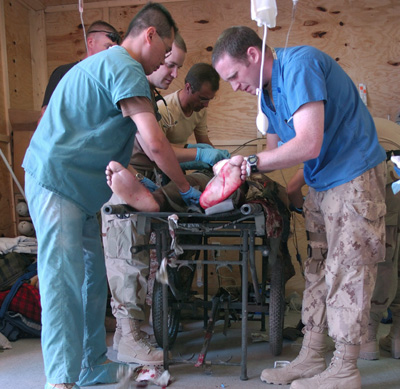And then all Hell broke loose
The seven trauma bays were filled and we quickly put up two more. Saline solution and water were poured on the patients in an effort to cool them down. Bandages and saline were used at an incredible rate. The smell of burnt flesh and gasoline filled the entire hospital. The floor was covered in water, dressings, clothing and charred flesh. Many of the patients were going into shock.
By now less than twenty minutes had passed since the arrival of the first casualties. As with previous MASCALs, the multinational flavour of the unit could be seen in each trauma bay. There were six severely burned patients; each with between 45 and 90 percent burns to their bodies. Canadians, Americans, Brits, Dutch, Australians, and Danes worked together at a frenetic pace.
It was obvious that our facility could not handle so many acutely ill patients, so we arranged to send two to the Dutch medical center in Tarin Kowt. They were intubated, bandaged and had IVs inserted. They were then taken by ambulance to a waiting U.S. Blackhawk helicopter.
{default}The specialists determined the best course of action for all the remaining patients. Nine patients were admitted to the ward. Only two of these could be considered minor cases. Three of the burn patients were intubated and mechanically ventilated. The ICU beds were now full.
The next morning we transferred two stable patients to Tarin Kowt. The Canadian and Danish surgical teams started debridement and changing dressings. This carried on for many hours. Later in the day we were able to release three patients and transfer one to the civilian hospital in Kandahar City. The three worst patients remained in ICU. The Internist and the Critical Care nurses worked non-stop on these three patients. The Head Nurse juggled schedules in order to provide Critical Care Nurse coverage for the burn patients. The norm in Canada is to have one nurse per ICU patient. Here, we had two nurses for three beds.
Just as we had discharged and transferred most of the burn patients on October 3rd, we heard about a mortar attack on Patrol Base Wilson. There were reports of casualties and two Canadians killed. For the second day in a row, we were to receive eleven casualties from one incident. The casualties were a mix of Canadians and Americans. Four required surgery and had to be admitted to the ward.

The next day, we prepared the two American and one Canadian patient for evacuation to the U.S. military hospital in Landstuhl, Germany. Meanwhile the burn patients remained on the ward. All three required one-on-one nursing care. For three days we tried to find a civilian facility that could take them. Finally, the Italian NGO hospital in Kabul said they could take two of our patients. On October 5th, we prepared two of the patients for transfer to Kabul. Our last burn patient, the most severely wounded, had no chance of survival. We were able to transfer him to the civilian hospital in Kandahar City so his family could be with him before he died. In all, four of the burn victims from this incident died.
As with the last two MASCALs, the staff worked non-stop to look after all our patients. Due to the severity of the injuries, this MASCAL was the most demanding. Burn patients are the absolute worst for supplies and resources.
In the first forty-eight hours we used up more burn supplies than had been used in the previous eight months, and we still had these three patients on our ward. By the time we transferred the last burn patient the Critical Care Nurses and Internist were, no pun intended, burned out.
Fortunately, no new patients came in and they were all able to have a full day of rest.
Maple Leaf/La Feuille d’érable
Canadian Forces
Discuss this article in our forums!

